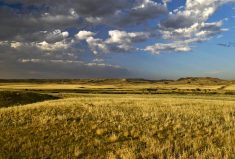At least five municipalities are waiting in the wings to join watershed districts, some for at least three years, but provincial funding is maxed out.
Conservation district members pressed Deputy Ag Minister Dori Gingera-Beauchemin and her staff for answers during a Q-and-A session at the recent Manitoba Conservation Districts Association conference in Winnipeg.
Half of the municipalities in the proposed watershed district of La Salle Redboine aren’t in the program, based on maps of the new districts.
“I believe for the district to survive it needs the extra dollars and needs them now, not 10 years down the road,” said Murray Seymour, who is currently a board member with Pembina Valley Conservation District.
Read Also

Province pledges funds to CentrePort Canada
The Manitoba government has pledged $450,000 towards projects at inland port CentrePort Canada.
The province funds the districts at a three-to-one ratio — for every $3 the province puts in, the municipalities must put in $1 minimum, a provincial spokesperson said in an emailed statement. The province contributed $5.3 million for 2019 to 2020.
“The provincial Watershed Districts Program is currently maxed out,” said MCDA general manager Sean Goertzen in an email. “Any new municipal members won’t get the three-to-one match, which means a district would have to thin out/spread around its existing core funding to do projects in the new municipality.
“This would likely upset a district’s existing members since they’d be getting less bang for their buck,” he said.
Goertzen added that the province recently introduced the Conservation Trust and GROW trust, which the districts can tap into for projects. However, he said, they’re not guaranteed funding and may not help convince municipalities to join the program.
The conservation districts program has been undergoing modernization, with changes expected to take effect in January. Among other changes, district boundaries will be realigned on watershed lines.
A provincial spokesperson told the Co-operator that program expansion has been on hold during modernization.
“The priority was to ensure that all 104 members continue their partnership in the modernized program,” the spokesperson said. “Now that we are at the end of the program modernization process and all 104 municipalities have remained in the program, we will be considering new municipalities that would like to join.”
















